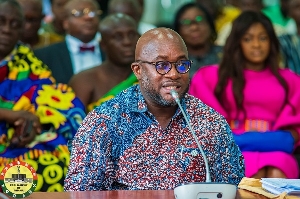Opinions of Thursday, 2 December 2010
Columnist: Koranteng, Kwabena Adu
Ghanain middle income status?
Kwabena Adu Koranteng –Email korantengadu@yahoomail.com- mob 0208456817
Not long ago, the Government Statistician, Ms Grace Bediako, organized a press
conference in Accra to announce that the country’s economy had expanded to US$48
billion from an estimated US$16 billion in 2008.
According to her, the development indicated that Ghana had reached a middle
income state.
I must say that the statement by the Government Statistician is debatable. Many
people that this reporter interviewed last week did not side with the claim that
Ghana had reached a middle income status and challenged her to bring real or
hard evidence to prove her claim.
If the investment drive of a country increases to US$48 billion, it doesn’t mean
that it has gotten to a middle income level.
Grace Bediako must know that all the foreign direct and indirect investment
capital circulating in the country and being used for mining, building of dams,
roads, among other investments, are monies that belong to individual investors,
either foreigners or locals. Others are also loans from multi lateral and
bilateral development partners that will be reimbursed.
These monies and profits made on them are remitted, leaving the country with
only royalties and taxes which are meager invariably nothing for balance of
payment, financing of budget and promotion of economic stability and growth.
Ghana is a country that outsources 40 percent of loans and grants from
development partners every year to finance its budget. How can such a country be
in the middle income level?
This is a country where growth is in the negative; the manufacturing sector is
collapsing; the service sector has outwitted the agricultural sector in terms of
growth just because everything from human underwear to toothpaste is imported.
The mining sector, which is usually held in high esteem, generates only 5
percent of the total revenue earned from the sector as royalties and taxes to
government every year. The major streets in Accra, Kumasi, and Takoradi as well
as Tema are all full of potholes that are now becoming ‘manholes’ and death
traps.
The agric sector has been in its traditional state where farmers are still using
cutlasses and hoes to farm - in the 21st Century - instead of mechanization.
The usual power outages by the Electricity Company of Ghana have become worse
than ever. Companies, factories and industries are struggling to have access to
energy to power their machines. Shortage of water in the capital city is the
order of the day. School children who are supposed to be in their classrooms are
seen roaming the streets everyday with their yellow jelly cans - usually called
‘Kufuor’ or ‘Atta Mills’ gallons - in search for water.
Water is scarce, electricity is … in Accra and in all the 10 regions. The roads
are in deplorable states. Even areas in Western and the Brong Ahafo Regions,
known for producing cocoa in large quantities, have roads that make it extremely
difficult to transport the cocoa beans to the ports of Takoradi and Tema for
export. Do you call this country a middle income one?
This is a country where maternal mortality has not yet reduced drastically.
After about four years of implementing the National Health Insurance Scheme,
things seem to be falling apart. The foodstuffs at Zubuzugu Tatale , Krachie,
Yeji and other great farming communities get rotten every harvesting season due
to poor road networks and lack of storage facilities.
Unavailability of adequate number of vehicles to transport workers after a
day’s work, shortage of petroleum products, expensive vehicle parts, and many
other things, are phenomenal. This is a country that imports about 800,000 tons
of rice annually at a cost of about one billion US dollars. There is no food
security because laws that promote food security are yet to be developed in
Ghana.
Ghana has become a country where a high percentage of graduates from the Senior
High Schools are unable to enter the universities. The orphans at the various
orphanages who deserve better treatment are taken through a barrage of
maltreatment and left to “rot alive.”
Government is currently finding it extremely difficult to include teachers,
doctors, nurses, medical officers in the Single Spine Pay Scheme due to the
threats posed by their huge number and the fear that it could pose a heavy
burden on the national wage bill, a factor that could cause the scheme to
collapse.
Is Ghana’s Statistical Service not aware of all these shortcomings, failures,
challenges, mentioned above and many more?
Ghana, I must say, is far from reaching a middle income status.
A middle income country boasts of first class streets in all its cities and
towns. It has 2nd class roads in its villages and food growing areas that
facilitate transportation of food stuffs and raw materials.
A middle income country boasts of sufficient and sustainable energy for
industrial and domestic use. It has treated water supply every day and boreholes
powered by other alternative sources of power like solar energy, in the rural
areas.
Such a country has affordable and quality education, high literacy and
employment rates, good health facilities that promote good health care and
reduces antenatal mortality.
A middle income country must have agricultural storage facilities; huge silos
that can store more than one million tons of various food stuffs reserved to
cater for emergencies and promote food security during food crisis. A middle
income country must have its agriculture sector mechanized to produce more food
for consumption thereby reducing high imports of other edibles.
The economic indicators alone, to me, are not enough to usher- Ghana into a
middle income level, though they are essential.












